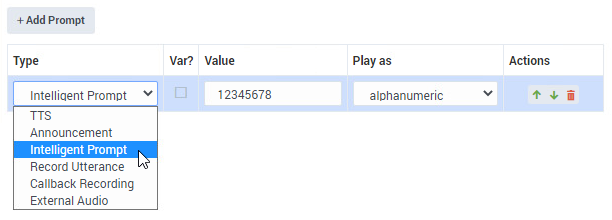Intelligent prompts
Contents
Intelligent prompts are pre-recorded audio files that sound similar to natural human speech. They can be arranged to be spoken in a way that adheres to regional standards, such as when presenting a currency denomination or a date.
About intelligent prompts
As an alternative to TTS, Intelligent Prompts play back pre-recorded audio files that sound more similar to natural human speech. They are also dynamic, in that you can arrange them to be presented in a format that is specific to a certain region, such as a currency denomination or a date standard. For example, you might need to specify Euros instead of Dollars, arrange the prompt so that the day is spoken before the month, or have a number spoken as an ordinal, where a number such as 21 is read back as "twenty-first".
Intelligent prompts can be used with the following types of items:
| Item | Description |
|---|---|
| Alphabetical characters | For example, "P". |
| Cardinals | Speaks a number as a quantity. For example, 1234 would be spoken as "one thousand, two hundred, thirty-four." |
| Currencies | Speaks a number as a specified currency denomination. For example, in the U.S. English (US-en) locale where dollars ($) are used, 11234 would be spoken as "eleven thousand, two hundred and thirty-four dollars." |
| Days | Speaks the specified day of the week. Days are numbered from 0-7, starting with Sunday. For example, 1 would be spoken as "Monday". |
| Months | Speaks the specified month. Months are numbered from 1-12, starting with January. For example, 5 would be spoken as "May". |
| Ordinals | Speaks a number as an ordinal. For example, 21 would be spoken as "twenty-first". |
Using intelligent prompts
Available languages
The languages that are available for playing intelligent prompts are listed on the Language tab in the Application Settings. From this tab, you can select the languages to be used for playing intelligent prompts.
Intelligent prompts are available for the following languages:
| Language | ISO Country Code | Voice Gender |
|---|---|---|
| Chinese (Hong Kong) | zh-hk | Female |
| English (Australia) | en-AU | Female |
| English (Great Britain) | en-GB | Female |
| English (United States) | en-US | Female |
| French (Canada) | fr-CA | Female |
| Italian (Italy) | it-IT | Female |
| Punjabi (India) | pn-IN | Female |
| Spanish (Mexico) | es-MX | Female |
If multiple languages are selected in the Application Settings, Designer uses the overall language setting in the application, such as the language set by the Language setting in the system variables or a Change Language block, to determine which language to use for playing intelligent prompts. If Designer is not able to play an intelligent prompt in the preferred language, it plays the prompt in the default fallback language. Unless changed, the default fallback language is en-US (English, United States).
Limitations
There are certain limitations to be aware of when using intelligent prompts:
Special characters
Special characters (including spaces) in intelligent prompts are not always interpreted the same by all languages. For example, one language might speak the words "special character" when playing back a special character in a prompt, while another language might ignore certain special characters completely. This can cause unexpected results when using the same prompts in multiple languages. Genesys recommends testing your prompts in each language you are using to ensure they are spoken as intended.

